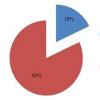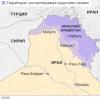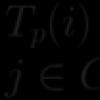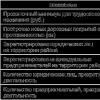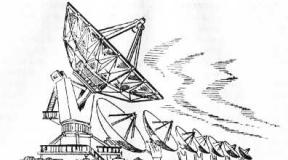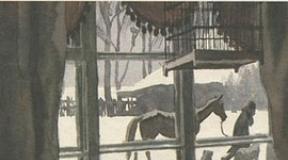The mechanism of chain reactions. Chain reactions, basic concepts, examples of chain reactions. Degenerate Forking Reactions
Chain reaction is a sequence of reactions in which a reaction product or by-product causes additional reactions. In a chain reaction, positive feedback leads to a self-expanding chain of events.
Chain reactions are one way in which systems in a thermodynamic nonequilibrium state can release energy or increase entropy in order to reach a state with higher entropy. For example, the system may not be able to achieve a lower energy state by releasing energy into the environment, because it somehow obstructs or impedes the path that will lead to the release of energy. If the reaction results in a small amount of energy release, allowing more energy to be released in the expanding chain, then the system will usually be destroyed by an explosion until most or all of the stored energy is released.
Thus, the macroscopic metaphor of chain reactions is a snowball, causing a larger snowball, until finally an avalanche effect (the "snowball effect") occurs. This is the result of accumulated gravitational potential energy seeking a path of release by friction. The chemical equivalent of an avalanche is a spark that causes a forest fire. In nuclear physics, a single stray neutron can lead to a fast critical event that may finally be energetic enough for a nuclear explosion or (in a bomb) a nuclear explosion.
Chemical chain reactions
Story
In 1913, German chemist Max Bodenstein first put forward the idea of chemical chain reactions. If two molecules react, not only are molecules of the final products of the reaction formed, but also some unstable molecules that can further interact with the parent molecules with a much higher probability than the original reagents. In the new reaction, in addition to stable products, other unstable molecules are formed, etc.
In 1918, Walter Nernst proposed that the photochemical reaction of hydrogen and chlorine is a chain reaction to explain the large quantum yield, meaning that one photon of light is responsible for the formation of as many as 10 6 molecules of the HCl product. He suggested that the photon dissociates the Cl 2 molecule into two Cl atoms, each of which initiates a long chain of reaction steps that form HCl.
In 1923, Danish and Dutch scientists Christian Christiansen and Hendrik Anthony Kramers, in their analysis of the formation of polymers, indicated that such a chain reaction should not start with a molecule excited by light, but it can also start with the fact that two molecules, K thermal energy, as it was proposed earlier for the initiation of chemical reactions of Van-t-Hoff.
Christiansen and Kramers also noted that if two or more unstable molecules are formed in one link in the reaction chain, the reaction chain will branch and grow. The result is, in fact, an exponential growth, which leads to an explosive increase in the rates of reactions and even to the chemical explosions themselves. This was the first proposal for a chemical explosion mechanism.
The quantitative theory of a chemical chain reaction was created by the Soviet physicist Nikolai Semenov in 1934. Semyonov shared the 1956 Nobel Prize with Sir Cyril Norman Hinshelwood, who independently developed many of the same quantitative concepts.
Typical steps
The main types of chain reaction steps are as follows.
- Initiation (formation of active species or chain carriers, often free radicals, at a thermal or photochemical stage)
- Propagation (may contain several elementary steps in the cycle, when the active particle as a result of the reaction forms another active particle, which continues the reaction chain, introducing the next elementary stage). In fact, the active particle serves as a catalyst for the general reaction of the propagation cycle. Particular cases are:
- Termination (the elementary stage at which an active particle loses its activity, for example, by the recombination of two free radicals).
Length chains is defined as the average number of repetitions of the propagation cycle and is equal to the total reaction rate divided by the initiation rate.
Some chain reactions have complex rate equations with fractional order or mixed order kinetics.
Detailed example: the hydrogen-bromine reaction
The reaction H 2 + Br 2 → 2 HBr proceeds according to the following mechanism:
- initiation
- Propagation (two-step cycle)
- Deceleration (deceleration)
- Ending 2 Br → Br 2
As can be explained using the stationary approximation, the thermal reaction has an initial rate of fractional order (3/2) and a complete rate equation with a two-term denominator (mixed-order kinetics).
Nuclear chain reactions
The nuclear chain reaction was proposed by Leo Szilard in 1933, shortly after the discovery of the neutron, but more than five years before nuclear fission was first discovered. Szilard knew chemical chain reactions, and he had read about nuclear energy, producing energy, involving high-energy protons bombarding lithium, demonstrated by John Cockcroft and Ernest Walton in 1932. Now Szilard has proposed using neutrons theoretically obtained from certain nuclei. Reactions in lighter isotopes to induce further reactions in lighter isotopes, which produced more neutrons. This would theoretically lead to a chain reaction at the nuclear level. He did not view fission as one of these neutron-producing reactions, as this reaction was not known at the time. The experiments that he proposed using beryllium and indium failed.
Later, after fission was discovered in 1938, Szilard immediately realized the possibility of using neutron fission as a special nuclear reaction necessary to create a chain reaction, while fission also produces neutrons. In 1939, Silbard with Enrico Fermi proved this neutron multiplication reaction in uranium. In this reaction, a neutron plus a fissioning atom causes fission, resulting in more neutrons than the one that was consumed in the initial reaction. This is how the practical nuclear chain reaction was born according to the mechanism of neutron fission of nuclei.
In particular, if one or more of the produced neutrons interact with other fissile nuclei and they also undergo fission, then there is a possibility that the macroscopic general fission reaction will not stop, but will continue throughout the reaction material. It is then a self-propagating and thus self-sustaining chain reaction. This is the principle for nuclear reactors and atomic bombs.
A demonstration of a self-sustaining nuclear chain reaction was performed by Enrico Fermi and others, in the successful operation of the first artificial nuclear reactor, Chicago Pile-1, in late 1942.
CHAPTER 22. CHAIN REACTIONS
22.1. Basic concepts of chain reactions
In some cases, in chemical reactions such active particles as free atoms and radicals, which have free valences and therefore have high reactivity, act as intermediates. These particles enter into reactions, as a result of which free atoms and radicals reappear. Such a sequence of periodically repeating reactions involving active particles (free atoms and radicals) is called chain reaction.
Although the formation of free atoms or radicals requires a high activation energy, their high reactivity and the appearance of new active species in reactions with saturated molecules lead to the fact that the rate of chain reactions is usually much higher than the rate of non-chain reactions. The nucleation at the beginning of the reaction of a small amount of reactive species leads to the conversion of a large amount of starting materials. Since chain reactions proceed cyclically, the active particle that appears at the end of the cycle gives rise to a new cycle, at the end of which the active particle is regenerated again.
Chain reactions include reactions of various classes. For example, combustion or slow oxidation reactions in the gas phase proceed by a chain mechanism:
2H 2 + O 2 2H 2 O
CH 4 + 2O 2 CO 2 + 2H 2 O
Chain reactions include many reactions involving hydrocarbons (polymerization, decomposition), photochemical reactions (formation of HCl, HBr, COCl 2, etc.), nuclear chain reactions - the decay of uranium-235 or plutonium in a nuclear reactor or bomb.
A characteristic feature of chain reactions is the high sensitivity of the rate of these reactions to the presence of certain impurities. For example, thoroughly dried hydrogen and oxygen react very slowly with each other, but the reaction proceeds at a normal rate in the presence of a small amount of water vapor. A mixture of hydrogen with chlorine does not react in the dark at room temperature, but reacts quickly when small amounts of sodium vapor are introduced into the system. In other cases, the presence of impurities leads to a sharp decrease in the reaction rate. For example, upon photochemical initiation of the reaction of hydrogen with chlorine, the rate of hydrogen chloride formation decreases by about a thousand times in the presence of one percent oxygen.
The rate of many gas reactions is influenced by the shape and material of the vessel in which the reaction takes place. Usually, reactions slow down as the ratio increases. S/V(S- the surface area of the vessel, V- its volume). This ratio can be practically changed by introducing fragments of the vessel material - glass, quartz, etc. into the vessel.
Many oxidation reactions in the gas phase are characterized by the fact that a fast reaction (spontaneous ignition) occurs only within certain limits of pressure and temperature. Figure 22.1 shows the dependence of the ignition limits on pressure and temperature, which is observed during the oxidation of hydrogen, phosphorus vapor, carbon disulfide, etc.
Rice. 22.1. Flammable limits for hydrogen oxidation reaction
The mixture ignites only under conditions corresponding to the shaded area in the figure, which is called peninsula of ignition... Outside the limits of the peninsula, no ignition occurs and the reaction proceeds at a low rate or practically does not occur at all. Starting from the point A, ignition can be caused by heating the mixture or reducing the pressure of the mixture to values lying in the region between curves II and I.The explanation of these features is provided by the theory of chain reactions, the development of which dates back to 1913, when the concept of a chain reaction was introduced by Bodenstein.
There are two types of chain reactions: with unbranched and branched chains... An example of the first type of reactions is the reaction of the formation of hydrogen chloride from hydrogen and chlorine
H 2 + Cl 2 2HCl,
the scheme of the mechanism of which was proposed by Nernst.
Three groups of reactions can be distinguished in the scheme. The process begins with chain initiation reactions:
Cl 2 Cl + Cl
This reaction of dissociation of a chlorine molecule into atoms can occur when light is absorbed
Cl 2 + h Cl + Cl,
thermally - in the collision, for example, of two chlorine molecules with increased energy:
Cl 2 + Cl 2 Cl + Cl + Cl 2,
chemically - for example, when a chlorine molecule interacts with a sodium atom, the vapors of which are introduced into the system. The resulting chlorine atoms are highly reactive and enter into further interaction with the starting materials, the second group of reactions occurs - chain development:
Cl + H 2 HCl + H
H + Cl 2 HCl + Cl
As a result of the first reaction, a hydrogen atom appears, which easily interacts with a chlorine molecule, as a result of which hydrogen chloride is formed and a chlorine atom is regenerated, which gives rise to the following link:
Cl + H 2 HCl + H
Cl H Cl H Cl ...
Under favorable conditions, such a chain can consist of many thousands of links. As a result, for one initially activated chlorine molecule, not two HCl molecules are formed, as in the usual bimolecular reaction, but thousands and tens of thousands of molecules.
For the given reaction, it is characteristic that one active particle is formed again for one active particle, Cl or H, that reacts. Such chains are called unbranched.
In addition to the above reactions of the nucleation and development of the chain, the third group of reactions occurs in the system - chain termination reactions leading to the death of active particles upon collision with any third particle M or the wall of the vessel S:
H + H + M H 2 + M
H + H + S H 2 + S
Cl + Cl + M (S) Cl 2 + M (S)
H + Cl + M (S) HCl + M (S)
In the presence of, for example, oxygen, chain termination can occur as a result of the reaction
H + O 2 + M  + M
+ M
The resulting inactive radical  dies on the walls of the vessel or by reaction
dies on the walls of the vessel or by reaction
 + НН 2 + О 2
+ НН 2 + О 2
At low pressures, active centers perish mainly on the walls of the vessel, and at high pressures, trimolecular breakdown occurs in the volume. Therefore, chain reactions are characterized by the features that were mentioned above - the dependence of the reaction rate on the specific surface area of the vessel, on the presence of any inert substance, on the pressure or concentration of the reacting substances.
The kinetic equation of an unbranched chain reaction can be obtained based on the reaction mechanism. For example, a detailed study of the reaction between hydrogen and bromine
H 2 + Br 2 2HBr
showed that the reaction proceeds in several elementary stages with different rate constants k:
Br 2 Br + Br k 1
Br + H 2 HBr + H k 2
H + Br 2 HBr + Br k 3
H + HBrH 2 + Br k 4
Br + BrBr 2 k 5
Based on this scheme, the rate of formation of hydrogen bromide can be represented by the equation:

 +
+
 –
–
 . (22.1)
. (22.1)
Considering bromine and hydrogen atoms as intermediate products, the Bodenstein principle of stationary concentrations can be applied to them (see Section 20.6):
From the sum of these equilibria we find the concentration of bromine atoms:
 . (22.4)
. (22.4)
After substituting this concentration into equation (22.3), we obtain the concentration of hydrogen atoms:
 . (22.5)
. (22.5)
Substitution of the concentrations of bromine and hydrogen atoms into equation (22.1) gives the final equation for the reaction rate:
 . (22.6)
. (22.6)
This equation coincides with equation (20.6) obtained from experimental data.
In a number of reactions, as a result of one elementary act, not one, but two or more chemically active particles can arise, i.e. branching of the chain occurs. Such reactions are called branched chain reactions... In such reactions, in the initial period of time, the number of active particles, and, consequently, the reaction rate, grows like an avalanche up to the moment when, due to the consumption of the initial substance, the reaction rate begins to decrease. An example of such processes is the hydrogen oxidation reaction, the mechanism of which, according to modern concepts, can be represented by a set of successively occurring elementary chemical acts:
 The origin of the chain
The origin of the chain
(4)
 + H 2 H 2 O + H Continuation of the chain
+ H 2 H 2 O + H Continuation of the chain
 Branching out the chain
Branching out the chain
 Open circuit on the wall
Open circuit on the wall
(9) H + O 2 + M  + M Open circuit in volume
+ M Open circuit in volume
Low-activity radicals formed  can disintegrate on the wall:
can disintegrate on the wall:
2 + SН 2 О 2 + О 2 + S
+ SН 2 О 2 + О 2 + S
At high pressures, reactions in volume are possible:
(10) + H 2 H 2 O 2 + H Continuation of the chain through
+ H 2 H 2 O 2 + H Continuation of the chain through
(11)
 + Н 2 ОН 2 О 2 +
+ Н 2 ОН 2 О 2 +  inactive radical
inactive radical
If the branching of a chain is carried out frequently, then even one originally formed chain can lead to the development of many chains. In the extreme case, one can imagine that branching occurs in each link, and then one speaks of a completely branched chain reaction. In other cases, branching may occur more rarely.
The existence of the lower and upper ignition limits can be qualitatively explained as follows. At pressures below the lower limit, active particles easily diffuse to the walls of the vessel, where they die. Breaking of chains on the walls predominates over branching, and a fast reaction does not develop. With increasing pressure, diffusion to the walls becomes more difficult, and the number of double collisions of the type (5) and (6) increases, which lead to branching of the chains; the nucleation and branching of chains begins to prevail over the cliff. As a result, the reaction is self-accelerating and can result in spontaneous combustion or explosion, which is what happens inside the ignition peninsula.

Rice. 22.2. Dependence of the rate of a branched chain reaction on time inside the ignition peninsula
With a further increase in pressure, triple collisions in the volume become more and more probable, leading to chain breakage. If the pressure exceeds the value of the upper limit II (Figure 22.1), the break begins to prevail over the development of chains and the possibility of a rapid reaction disappears.The ignition of the combustible mixture inside the ignition peninsula is preceded by an induction period t ind (fig.22.2). It is explained by the fact that at first the number of chains can be very small and the reaction is practically invisible due to the insufficient sensitivity of the analysis methods. But after a while t the number of chains grows very quickly due to their multiplication, and spontaneous combustion or explosion occurs. Reaction rate dependence v from time t can be represented by the equation:
 , (22.7)
, (22.7)
where A and - constant for a given reaction and depending on a number of conditions. When deriving this dependence, the decrease in the concentration of reactants due to burnout was not taken into account, therefore, the tendency of the speed to infinity over time has no physical meaning - the speed becomes large, but not infinite.
In some cases, a third flammable limit is observed (Fig. 22.1), which lies at higher pressures. Its existence is associated with the course of chain reactions due to low-activity radicals or with the development of a thermal explosion.
22.2. Elementary theory of chain reactions
There are two versions of the theory of chain reactions - a more rigorous one, based on solving a system of differential equations, and a less rigorous, but more visual probabilistic version, which is considered below.
An important characteristic of a chain reaction is the average chain length - the average number of elementary reactions caused by one active particle (atom or radical), which arose initially in some independent way. If n o is the number of such independently occurring particles per unit time per unit volume, then n o can be called chain initiation rate.
The reciprocal of the average chain length is open circuit probability. This relationship can be understood using the schematic diagram of the circuit in Figure 22.3. On the diagram, a dot means the appearance and regeneration of an active particle, and a cross means its death, i.e. open circuit.

Rice. 22.3. Schematic representation of a chain reaction:
a- unbranched chain; b- branched chain
For one favorable case - a break - there are only cases, therefore, =1/ . (22.8)
Let us also assume the possibility of chain branching - the appearance in any link of two or more active particles and characterize this possibility branching probability .
Let us denote by the time during which, on average, one link in the chain reaction proceeds. Then the product is equal to the average travel time of the entire chain from the moment of initiation to the break. The concentration of active particles, i.e. their number per unit volume, let it be n... The rate of change in the concentration of these particles will be equal to the difference in the rates of their formation n o and disappearance.
If the chain length = 1 (i.e., in fact, there is no chain), then the active particle dies in each link. Then, for the average development time of one link everyone will react n particles, and the disappearance rate will be n/ particles / cm 3 With... If the chains develop and their average length is > 1, the particle on average will react times, and the average time of her life will be equal ... Consequently, the rate of decrease in the concentration of particles will be expressed by the relation
 . (22.9)
. (22.9)
If branching is possible, i.e. > 0, then its influence can be taken into account, assuming that the branching acts, as it were, in the direction opposite to the termination, lengthening the chain and reducing the probability of termination to the value ( – ). Then, for the rate of change in the concentration of active particles, we can write the expression:
 . (22.10)
. (22.10)
The solution to this differential equation can be carried out as follows. For simplicity, we introduce the notation a= ( – )/ ... Then
 . (22.11)
. (22.11)
We assume at the outset that n o = 0, and after separating the variables we get:
 , (22.12)
, (22.12)
whose integration gives:
ln n = –at + ln Z(t), (22.13)
where Z(t) Is some conditional “constant” of integration. Then
n=Z(t)e –At . (22.14)
Let us differentiate this equation taking into account that Z is not constant:
From a comparison of this equation with equation (22.11) it follows that
 (22.16)
(22.16)
 . (22.17)
. (22.17)
After integrating this equation, we get
 , (22.18)
, (22.18)
where I- constant of integration. Substitution of this quantity into equation (22.15) gives
 . (22.19)
. (22.19)
From the condition that at the initial moment of the reaction ( t= 0) the quantity n= 0, it follows that
 (22.20)
(22.20)
 . (22.21)
. (22.21)
After substitution of the value a get
 . (22.22)
. (22.22)
Speed reaction v can be defined as the rate of increase in the concentration of molecules of the reaction product. Since in one link at a time one molecule appears, then the total number of molecules formed per unit volume per unit time is equal to n/ ... Thus, we get the basic equation of the theory of chain reactions:
 . (22.23)
. (22.23)
Consider the use of this equation for some special cases.
When an unbranched chain reaction occurs = 0. Since the average length of the chain = 1/ , then the rate of such a reaction is
 . (22.24)
. (22.24)
 Rice. 22.4. Time dependence of the chain reaction rate:
Rice. 22.4. Time dependence of the chain reaction rate:
1 – = 0; 2 – 0 < < ; 3 – >
As follows from this equation, the reaction rate should increase over time and reach a limit equal to n o = n o / (fig.22.4), i.e. the system must reach a steady state in which the reaction rate is constant. This speed in times the rate of nucleation of primary reactive particles n o, i.e. reaction rates in the absence of chains ( =1).If a branched chain reaction is possible, the branching probability may turn out to be less than the termination probability, i.e. 0< < ... In this case, according to equation (22.23), the system must also reach a stationary speed, but this speed is greater than in the first case:
If the branching probability is greater than the breaking probability, i.e. > , equation (22.23) takes the form:
 , (22.25)
, (22.25)
where A and are positive constants. The resulting equation coincides with the previously given equation (22.7). The equation shows that the reaction rate can become infinitely large (Fig. 22.4), i.e. indicates the possibility of a chain ignition or explosion.
However, it should be noted that the obtained dependences refer to some idealized reaction conditions - it is assumed that the concentrations of the starting materials are kept constant, and the reaction products are removed from the reaction zone. Under real conditions, for example, when the reaction is carried out in a closed vessel, the initial substances “burn out”, and the products remain in the reaction mixture. Therefore, for unbranched chain reactions or for branched reactions with < the velocity passes through the maximum (dotted line in Figure 22.4). It is possible that the stationary state will not be achieved at all, since the maximum speed may turn out to be less than the stationary one. In the case of a branched chain reaction with > taking into account the burnout of reagents should give, as already indicated earlier, a very high, but still final rate.
Condition > corresponds to the reaction in the region of the ignition peninsula, and the condition > - outside of it. Thus, the theory of branched chain reactions quantitatively explains the existence of the lower and upper ignition limits.
Self-heating of the reacting mixture can also lead to ignition or explosion, regardless of the reaction mechanism. According to the Arrhenius equation, the reaction rate increases with increasing temperature exponentially, while the rate of heat removal is slower (proportional to the temperature difference). In the case of an exothermic reaction, if heat is not removed from the reaction zone at a sufficient rate, the reaction mixture will begin to self-heat, and the reaction rate will increase more and more. The development of these processes can lead to ignition of the reaction mixture or explosion. In this case, they talk about thermal self-ignition(thermal explosion). The kinetics of thermal self-ignition may not differ externally from the kinetics of chain ignition, which must be borne in mind when studying reactions that turn into ignition or explosion.
On the basis of the electronic theory and the theory of the structure of molecules and atoms, new prerequisites for the development of chemical kinetics were created.
By the beginning of the XX century. chemical kinetics had: 1) the concept of active molecules; 2) classification of reactions, considering mono-, bi- and trimolecular; 3) the doctrine of intermediate products; 4) the first theories of combustion and explosions.
Already at the end of the XIX century. there is a noticeable turn in the direction of research in chemical kinetics. The center of gravity is gradually shifting from the study of reactions in the liquid phase to the study of reactions in the gas phase (Bodenstein, Haber and their schools). This was mainly due to two reasons. From the scientific point of view, this was due to the fact that the apparatus of the kinetic theory of gases, which was brilliantly developed by that time, could be successfully applied to reactions in the gas phase. On the practical side, this was caused by the demands of the developing industry (improvement of internal combustion engines; widespread introduction of gas reactions in the chemical industry, etc.).
In 1899 M. Bodenstein published an extensive study entitled "Gas Reactions in Chemical Kinetics." He comprehensively investigated the formation and decomposition of HI, H 2 S, H 2 Se and H 2 O at different temperatures. He showed that these reactions proceed according to the theory of Van't Hoff and do not form false equilibria, as pointed out by Pelabon, Duhem and Gelier. The data obtained by D.P. Konovalov were consistent with Bodenstein's conclusions.
Bodenstein is credited with developing the method of stationary concentrations. He showed that the concentration of active particles soon after the onset of the reaction acquires a stationary value, that is, the rate of their appearance becomes equal to the rate of their consumption. In this case, the concentration of active particles can be expressed in terms of the concentration of the starting substances.
For elementary reactions, the representations of Van't Hoff and Arrhenius are quite valid. However, most of the reactions actually occurring, as was shown later, are associated with a sequence of mutually related elementary reactions. This complex total reaction no longer fits into the simple laws for mono- and bimolecular reactions. Therefore, more and more deviations from the Van't Hoff kinetic laws accumulated. It was necessary to find out the hidden reasons for these deviations. This begs the question, do these deviations reflect some new kinetic regularities unknown to Van't Hoff and Arrhenius? Chain theory paved the way for investigating the nature of complex reactions.
The concept of chain reactions was first formulated with full clarity as a result of the study of photochemical reactions.
Studying Einstein's law, according to which the number of reacted molecules is equal to the number of absorbed light quanta, Bodenstein, using the example of the photochemical reaction of the combination of chlorine with hydrogen, showed that in this case Einstein's law does not hold even approximately: the absorption of one quantum of light caused a reaction of a large number of molecules. This number underwent significant changes depending on the experimental conditions: under favorable circumstances, the number of reacting molecules reached 1,000,000 per absorbed quantum of light.
To explain this fact, Bodenstein suggested that the absorption of light causes ionization of the absorbing particle, resulting in the formation of an electron and a positively charged residue. Bodenstein considered the reaction between a positive residue and a normal molecule of matter as primary.
He imagined the secondary reaction as the addition of the electron released during the absorption of light to neutral molecules, which became active in this case and thereby ensured the continuation of the reaction. If this reaction, in turn, creates some kind of active molecule, etc., then a number of elementary reactions will take place, depending not on the initial conditions of the experiment, but on distinguishable factors affecting the excess energy of the molecule. In this case, an interruption of the secondary reaction may occur.
However, such an ionization reaction mechanism was soon abandoned, since no free electrons were found when chlorine was illuminated with light. In this connection, Bodenstein and Nernst proposed other possible reaction mechanisms.
Bodenstein in 1916 suggested that the absorption of a light quantum by a chlorine molecule leads not to the release of an electron, but to the direct creation of an active chlorine molecule. The latter has energy sufficient to react with a hydrogen molecule, and two molecules of hydrochloric acid are formed, one of which is rich in energy, that is, is active. When colliding with another chlorine molecule, such a molecule transfers its energy to it, and thus a new active molecule is formed, interacting with a hydrogen molecule. This goal will continue until the molecules of hydrochloric acid or chlorine, which are carriers of energy, do not lose it in some way, for example, when colliding with the wall of a vessel or with a molecule of an extraneous gas (in particular, oxygen, which significantly inhibits this reaction).
Marking an active molecule with an asterisk, you can represent the reaction mechanism, according to Bodenstein, as follows:
Cl 2 + hν → Cl 2 ∙
Cl 2 ∙ + H 2 → HCl ∙ + HCl
HCl ∙ + Cl 2 → Cl 2 ∙ + HCl
Cl 2 ∙ + H 2 → HCl ∙ + HCl, etc.
In 1918, Nernst proposed a different reaction mechanism. Explaining the anomalies in photochemical reactions, Nernst, using the example of the photochemical combination of chlorine with hydrogen, proposed the following chain mechanism to explain the reason for the large quantum yield of this reaction:
Cl 2 + hν → Cl + Сl
Cl + H 2 → H + HCl
H + Cl 2 → Cl + HCl
Cl + H 2 → H + HCl, etc.
According to this mechanism, chlorine atoms, combining with hydrogen molecules and forming hydrogen chloride, release hydrogen atoms, and the latter, in turn, combining with chlorine molecules, also form hydrogen chloride and reduce free chlorine atoms. Hence, when chlorine molecules decompose under the action of light, a large yield of hydrogen chloride is observed.
The study of such reactions with particular clarity has shown that a chemical process is far from a "one-act drama" during which the interaction of reacting molecules directly leads to the formation of final reaction products. In reality, in the course of a chemical reaction, labile intermediates are formed, which interact with the molecules of the starting substances. Along with the formation of the final product, the regeneration of the active particle can take place. In this case, the reaction will proceed by a chain mechanism.
Until 1925, attempts by a number of authors to extend Nernst's ideas about the active role of free atoms to various reactions were of a single nature, and Nernst's concept remained “as it were a separate exception among all reactions of chemistry, which continued to be interpreted from the point of view of the old ideas about direct mono - and bimolecular processes ".
In 1919, Christiansen and Herzfeld, and Polanyi in 1920, spread Spawn's ideas about chain mechanism of reactions to the thermal reaction of bromine with hydrogen 7.
In 1923, Christiansen and Kramer in Copenhagen used the concept of the chain nature of chemical reactions to explain the deviations of the constant K 2 in the monomolecular theory of decay of N 2 O 5. The authors applied the idea of "energy value" to thermal reactions, according to which "hot" molecules formed during the reaction due to the release of the heat of reaction have active properties. Such active molecules, upon collision with others, excite an elementary reaction act, thereby initiating a valuable reaction.
Christiansen and Kramere showed that a chemical reaction itself is a generator of active centers. The studies of these chemists have generated an increased interest in the problems of chemical kinetics. Both in terms of new provisions and in their influence, the works of Christiansen and Kramers occupied a prominent place in the history of chemical kinetics in the 1920s.
In 1926-1929. three cycles of work in the field of chemical kinetics appeared almost simultaneously. These are, firstly, work on the study of the ignition conditions for sulfur and phosphorus vapors, as well as on the determination of the ignition temperatures of various gas explosive mixtures, carried out by N.N. second, the work of Hishnelwood at Oxford in England on the study of the reaction of the H 2 + O 2 compound near the explosion temperature; third, the work of Backstrem on the oxidation of benzaldehyde, Na 2 S 2 O 3. and so on, made at Taylor's lab at Iripstop.
In 1926, 10. B. Khariton and RF Walta in the laboratory of NN Semenov studied the quenching of the chemiluminescence of phosphorus and came across the phenomenon of the cessation of the luminescence of phosphorus vapors in a mixture with oxygen at low pressures. If the pressure was less than 0.05 mm, there was no luminescence, and whenever the oxygen pressure exceeded this critical value, the luminescence immediately appeared again.
The explanation of this amazing phenomenon, given by Semenov, went far beyond a simple description of a particular case of phosphorus vapor glow. Semenov, on the basis of studying the reaction of phosphorus oxidation, made the far-reaching conclusion that such a reaction is a chain reaction proceeding with the participation of free radicals, which play the role of active centers.
In his book "Chain Reactions" Semenov notes two stages in the development of chain theory. The first of them was associated with the study of photochemical reactions and led to the creation of the theory of non-branching chains; the second, which began in 1927, is associated with the study of thermal reactions of ignition and is marked by the introduction of the concept of chain branching into chain theory. "... The role played by the reaction Н 2 + С1 2 in the first stage fell to the share of the reaction of oxidation of phosphorus and oxidation of hydrogen in the second," Semenov writes.
The starting point of the chain theory is that the energy released during the exothermic reaction (E + Q), at the first moment, is concentrated in the reaction products, creating particles with very high energy. Thus, the reaction itself, along with thermal motion, can become a source of activations. Hence, each elementary reaction causes the next, thereby creating a chain of reactions.
If α is the probability of this kind of chain continuation, and n 0 is the number of primary reactions created every second by thermal motion, then the reaction rate:
W 0 = n 0 / (1 − α) = n 0 / β
where β = 1 − α is the chain termination probability.
The appearance of the first work on the combustion of phosphorus was met abroad at first very hostilely, Semenov recalled in 1932. The most prominent scientist in In the field of kinetics of gas reactions, Bodenstein and the press sharply criticized the work, considering the results to be erroneous. He wrote something like this: “There is an attempt to bring to life the phenomena of false equilibria, the impossibility of which was proved 40 years ago. Fortunately, this attempt, like all the previous ones, is based on methodological errors. " Only after we proved the correctness of our results by other methods and after we created a theory explaining these phenomena - the chain theory of ignition - the attitude of foreign scientists, and above all of Bodenstein himself, changed dramatically. In November 1927, Bodenstein, in a letter to me, abandons the previous opinion in the following words: “I have studied our new article on the oxidation of phosphorus vapors with great interest and I will say that now I can not object to your interpretation. Thus, I can congratulate you and Khariton on wonderful and highly interesting results. " In March 1928, after the appearance of my theoretical article and an article on sulfur oxidation, he wrote to me: “Your results with the combustion of phosphorus and sulfur in relation to classical kinetics are revolutionary. And if these experiments are really correct, then significant changes will have to be introduced into classical kinetics. "
The study of the mechanism of complex reactions and the nature of intermediate products required the development of new equipment and methods (kinetic) for studying the details of the chemical process.
“The most important thing,” Semyonov wrote, “was that the theory went hand in hand with new experiments, leading to the discovery of new and explanation of old, long forgotten and completely incomprehensible phenomena. These works led to the quantitative formulation of new chain patterns common to a whole large class of phenomena, and outlined the area of reactions that is specific to new concepts. They raised widespread interest in this new field of reactions and brought to life in 1930-1933. a broad wave of new kinetic research. Therefore, we are inclined to believe that these works laid the foundation for a new development of chemical kinetics. "
From this moment, a new stage in the development of chemical kinetics begins, when it was theoretically and experimentally shown that the chain reaction mechanism is the main type of chemical transformations carried out with the help of free atoms and radicals.
In 1932, Semenov developed a theory of chain interactions based on the connection of an ordinary chemical chain with an energy chain, where the main role is played by "hot" molecules with increased chemical activity. Semenov showed that the chain mechanism of most reactions is not accidental; it depends on the most general and profound relationships between the energy of a chemical bond, the heat and the activation energy of the reaction.
In 1934, Semenov's monograph "Chain Reactions" was published, where the theory of chain branching and their breaks on the walls of blood vessels was developed on the basis of rich experimental material.
In the conclusion of his book, Semenov wrote: “... The development of statistics of stationary processes, combination with a detailed study of elementary acts of energy transfer, and the nature of molecules and atoms arising in this process as intermediate products, is, in our opinion, the main line of development of theoretical chemistry for the next decades ".
The concept of branched reaction chains, proposed by Semenov to explain the kinetic features of complex oxidative reactions, was the beginning of a new stage in the study of the mechanism of complex reactions. Over the past 30 years, a huge number of works have appeared devoted to a detailed study of the mechanism of various processes, intermediates, in particular free radicals.
A large cycle of research was devoted to the study of elementary chemical processes, where the properties of each individual molecule are most clearly manifested. This made it possible to penetrate deeply into the innermost mechanism of a complex chemical process, consisting of a set of elementary processes.
An important achievement of the valuable theory was the experimental proof of the existence of significant concentrations in the zone of gas reactions of free radicals - hydroxyl and hydrogen atoms, the interaction of which with the molecules of the mixture determines the course of the reactions.
In the 30s, in this regard, much attention was paid to the study of the nature of active intermediate products - chemically unstable particles that appear in the development of a chemical reaction and are directly involved in its course.
For a long time nothing was known about the nature of active centers - participants in chemical reaction chains. In the 1930s, to study the physicochemical properties of chemically unstable free atoms and radicals, in particular free hydroxyl, the spectroscopic absorption method developed by Oldenberthum in the USA and the line absorption method developed by V.N.Kondratyev in the USSR were successfully applied. ...
“Until recently,” wrote V. N. Kondratyev in 1944, “the development of chemical kinetics proceeded along the line of establishing microscopic regularities and constructing formal kinetic reaction schemes without their proper chemical substantiation. The question of the chemical nature of the active centers of the reaction was either left completely open, or it was decided on the basis of more or less convincing indirect considerations not supported by direct experiment. However, the development of modern physicochemical research methods radically changed the state of affairs and laid the foundation for the systematic study of reactions from the point of view of the chemical substantiation of their internal mechanism. Among the new effective methods for the identification and analysis of active intermediates, the spectroscopic method should be mentioned first; ortho- and para-hydrogen method; the method of mirrors and, finally, the method of radioactive indicators. "
The works of V.N.Kondratyev and his students gave quantitative measurements of the concentration of intermediate substances, which makes it possible to establish quantitative regularities, which are a prerequisite for not only a chemical, but also a mathematical substantiation of the reaction mechanism.
Experimental evidence of the participation of free radicals, fragments of molecules with unsaturated valences in individual stages of chemical reactions was of paramount importance for the further development of chemical kinetics.
Chain reactions chemical and nuclear reactions in which the appearance of an intermediate active particle (a free radical, an atom or an excited molecule in chemical processes, a neutron in nuclear processes) causes a large number (chain) of transformations of the initial molecules or nuclei due to the regeneration of an active particle in each elementary reaction ( at each link in the chain). For nuclear processes, see Nuclear Chain Reactions.
In the studied unbranched chemical flowering plants. active centers are free atoms and radicals capable of easily, with a low activation energy (see Activation energy), to react with the original molecules, giving rise, along with the product molecule, to a new active center. In branched chemical Ts. R. excited molecules can also act as active centers, and in the so-called. degenerate-branched reactions (see below) are also unstable molecules of intermediate substances. Unbranched Ts. R. Chemical processes with unbranched chains can be considered by the example of the photochemical reaction between hydrogen and chlorine. In this Ts. R. a chlorine molecule, absorbing a quantum of light, decays into two atoms. Each of the formed chlorine atoms begins a chain of chemical transformations; in this chain, chlorine and hydrogen atoms act as active species. The chain length can be very long - the number of repeated elementary chain continuation reactions per one nucleated active center can reach tens and hundreds of thousands. Breaking of chains occurs as a result of the recombination of atoms in the volume of the reactor, the capture of atoms by its wall followed by recombination on the wall, the formation of an inactive radical during the reaction of active centers with molecules of always present impurities [for example, during the reaction between atomic hydrogen and oxygen molecules (impurities) with the formation of a radical HO 2; this radical does not react with the parent molecules under conditions of not very high temperatures]. The reaction between H 2 and Cl 2 caused by the action of a quantum of light hν ,
can be represented by the diagram: In the last two stages, M is any third particle (atom or molecule) that is needed in order to take away some of the energy from the resulting Cl 2 and HO 2 particles and thereby make their reverse decay impossible. Speed Ts. R. is extremely sensitive to the rates of nucleation and termination and therefore depends on the presence of chemical impurities, on the material and state of the walls of the reaction vessel, as well as on its size and shape. The rate of reactions with unbranched chains (W) is W=w 0ν
=w 0 W p / W obr where w 0 - chain nucleation rate, ν - chain length, W p and W obr- respectively, the speed of continuation and breakage of chains ( W obr can be a composite value reflecting different paths of circuit breakage). A large number of practically important reactions proceed according to the unbranched chain mechanism, in particular Chlorination ,
a series of liquid-phase oxidation reactions (see Oxidation) of organic compounds, thermal cracking. Polymerization is also a peculiar process with unbranched chains. ,
in which the chain of reactions simultaneously determines the length of the polymer molecule. The formation of active particles necessary for the nucleation of chains occurs when one of the bonds in the molecule breaks and is always associated with the expenditure of energy. Free radicals can be obtained from external sources of energy, for example, a quantum of light absorbed by a molecule during a photochemical reaction, as well as the energy of electrons generated in an electric discharge or exposure to α-, β- and γ-radiation. The most important in practical terms is the formation of free radicals due to the internal thermal energy of the system. But the binding energy in most molecules is high and, the energy of their direct dissociation into radicals is much high, therefore, through the direct disintegration of the initial molecules, C. p. are initiated only at more or less high temperatures. Often, however, chain initiation occurs with the participation of various initiator impurities. Such impurities can be molecules with a weak bond, during the decomposition of which radicals that start chains are easily formed, or molecules that easily enter into redox reactions, for example, Fe 2+ + H 2 O 2 → Fe 3+ + OH - + OH. Initiation can also take place on the wall of the reaction vessel. In this case, the activation energy decreases due to the fact that the adsorption energy of one of the radicals is used in the system. Chains can also arise as a result of reactions between molecules. Some of these reactions proceed fairly quickly even at low temperatures, for example, F 2 + C 2 H 4 →
F + C 2 H 4 F. The concept of unbranched Ts. arose as a result of the work of the German scientist M. Bodenstein, who discovered (1913) that in a number of photochemical reactions one absorbed quantum of light causes the transformation of many molecules. In particular, during the formation of HCl from H 2 and Cl 2, on average, for each absorbed quantum, up to 1,000,000 HCl molecules are formed. Since one quantum can activate only one molecule, the rest react without direct exposure to light. The mechanism of this reaction was proposed by V. Nernst (1916). The modern theory of reactions with unbranched chains was created and developed by the Bodenstein school, as well as by the works of Soviet scientists. Branched chain reactions. Reactions in which chains branch out have very special properties. These reactions were discovered in 1926-28 by a group of Leningrad physicists using the example of the oxidation of phosphorus vapors. It was found that with a small change in any parameter of the reaction system (concentration of reagents, temperature, vessel size, impurities of specific substances), and even when diluted with an inert gas, an almost imperceptible reaction abruptly transforms into a fast, self-accelerating process such as self-ignition (See Self-ignition). This phenomenon takes place even at low temperatures, when the rate of nucleation of such processes is extremely low, and also under conditions when a thermal explosion is impossible. Therefore, outside the ignition area (see. rice.
) there is practically no reaction. NN Semyonov and his co-workers were the first to explain this paradoxical fact and to create a quantitative theory of branched flowering systems. Significant contribution to the development of the concept of branched flowering. also contributed the pioneering work of S. N. Hinshelwood and co-workers on the study of the upper flammability limit. Semyonov and Hinshelwood were awarded the Nobel Prize in 1956 for their studies of the mechanism of chemical reactions. In the course of branched Ts. R. when one of the active centers interacts, more than one (often three) new active center appears, i.e., the multiplication of chains occurs. An example of a branched Ts. R. oxidation of hydrogen can serve, where the branching and continuation of chains occurs according to the scheme: (1) H + O 2 → OH + O - branching or in the sum H + 3H 2 + O 2 = 2H 2 O + 3H. Along with the active centers H and OH formed in reactions 1-3, which ensure the development of an unbranched chain, an oxygen atom is formed in reaction (1), which formally has two free valences and is able to easily enter into reaction (3) with the formation of H and OH - two more chain carriers. This type of branching has been called material. In reactions with the so-called. By energetic branching, the multiplication of chains is carried out at the expense of excited particles - the products of exothermic reactions of chain development. For example, when fluorine interacts with hydrogen, the chains develop according to the scheme: (2) F + H 2 → HF * + H (3) H + F 2 → HF * + F (4) HF * + H 2 → HF + H 2 * (5) H 2 * + F 2 → HF + H + F In reactions (2) and (3), along with the H and F atoms, vibrationally excited HF * molecules are formed, which transfer the excess energy to the H 2 molecule [reaction (4)]. As a result of the collision of an energy-rich H2 * molecule with an F 2 molecule, an HF molecule and H and F atoms are formed [reaction (5)], initiating new chains (energetic branching). Experimental data were obtained in the USSR (1970s), which, apparently, can be considered as confirmation of the idea expressed by Semenov (1934) about the possibility of energy branching with the participation of electronically excited particles. The rate of the branched-chain process in the gas phase in the initial stages (up to the burnout of 30-40% of the gas) is expressed by the formula where k is the rate constant of the reaction of the active center with the starting substance, [A] is the concentration of the starting substance, w 0 - chain initiation rate, f and g-
respectively, the effective rate constants of branching and termination, e - base of the natural logarithm, t - time. Under conditions when ( f - g)> 0, the concentration of active centers and the rate W grow like an avalanche in time. If ( f - g) w o. The transition from one reaction mode to another is carried out practically in a jump under the critical condition ( f- g) =
0. The rate of chain branching is proportional to the concentration of the molecular reagent that reacts with the active site. At the same time, the rate of heterogeneous chain termination on the vessel wall, depending on the state of its surface, may not depend on the concentration or decrease with an increase in the concentration of the gas-phase mixture. Therefore, when the pressure rises, starting from a certain value (first limit), f getting bigger g and the mixture spontaneously ignites. If the chain termination occurs during triple collisions, then its rate is proportional to the product of the total concentration of the mixture and the concentration of the initial reagent, which forms a low-activity radical with the active center. With a further increase in pressure, starting from a certain value (upper limit), the break prevails over the branch ( f g) ,
and no ignition occurs. The pressure at which f=g, called critical pressure. For similar reasons, for branched Ts. there is also a critical autoignition temperature. Since the branching rate is more dependent on temperature than the breaking rate, the ignition region expands with increasing temperature. Curves expressing the critical pressure as a function of temperature have the form of the so-called. chain ignition peninsula (see. rice.
). As an example, the peninsula of ignition for the oxidation of silane at different contents in oxygen are given. A similar picture is observed for almost all oxidation reactions and many fluorination reactions. The experimentally observed dependences are fully consistent with theory. With a heterogeneous break, the value g, and hence the rate of death of active centers is proportional to the ratio of the inner surface of the vessel to its volume, that is, it is inversely proportional to the diameter of the vessel. Accordingly, there is a critical diameter. At diameters slightly larger than the critical one, the reaction proceeds with ignition; at smaller diameters, the reaction is virtually absent. If for mixtures the values f and g close to each other, but still f g, such mixtures can be ignited by adding an inert gas. The addition of an inert gas at a constant concentration of reagents hinders the diffusion of active centers to the walls of the vessel and thereby decreases the rate of termination (the value g).
If there is an admixture of a substance in the system, in the reaction with which the active centers die, then above a certain critical concentration of this substance, chain termination prevails over branching and the mixture does not ignite. Below this critical impurity concentration, ignition of the mixture can occur. The theory makes it possible to calculate the change in the concentration of active centers over time. Calculations show that, near the maximum rate of the chain process, the concentrations of active centers can reach enormous values, much exceeding their thermodynamically equilibrium concentrations (it is obvious that by the end of the process, the concentrations of active centers become vanishingly small due to the recombination of atoms and radicals). Indeed, in accordance with the theory in various branched Ts. R. Atoms and radicals have been directly detected in concentrations comparable to those of the starting substances. Thus, during the decomposition of NCl 3 at room temperature and low pressures, the concentrations of intermediate active species - chlorine atoms - reach 40% of the initial content of NCI 3. In 1939, V.N.Kondratyev and his coworkers in the study of hydrogen-oxygen flame, and then N.M. thermodynamically equilibrium values. Later, for the identification of atoms and radicals in flames, V.V. Voevodsky and his co-workers successfully used the method of electron paramagnetic resonance for the first time. This method is widely used in the study of various branched flowering plants. It is not excluded that the area of chemical processes proceeding by the branched chain mechanism is wider than usually assumed, and there is much that has not yet been investigated. It is known, for example, that at a high rate of recombination of active centers among themselves, processes with branched chains can imitate the regularities of reactions of simple types. Under these conditions, the chain mechanism is not easy to install. This was done, for example, in the reaction of liquid-phase oxidation of stannous compounds. Critical phenomena, to a certain extent similar to those described above, are observed in some heterogeneous catalytic reactions. Branched Ts. R. are not only chemical and nuclear reactions. The phenomenon of coherent laser radiation, for example, also belongs to the number of branched chain processes. Degenerately branched C. p. Reactions of this type were predicted, discovered, and then studied in detail at the Institute of Chemical Physics of the Academy of Sciences of the USSR. With the development of unbranched chains, an intermediate molecular product such as peroxides is often formed, which decomposes relatively easily, but still not too quickly, into free radicals, which start additional new chains. In this case, a strongly delayed branching takes place and a slow self-accelerating reaction, called degenerate branching, takes place. Such reactions are accompanied by a long, sometimes one-hour period of induction (or rather, a period of latent autoacceleration). These include the oxidation of hydrocarbons and many other organic compounds. Limiting (critical) phenomena are also characteristic of many degenerate-branched reactions in the gaseous and liquid phases, but they do not manifest themselves as often as in ordinary branched cycling systems. Peculiar reactions of the degenerate-branched type also occur in solids, for example, during the slow thermal decomposition of ammonium perchlorate crystals. In crystals, the direct decomposition of the initial substances is extremely difficult and begins at defects, primarily at dislocations, along which the final substances - gases or solid products - are formed. During reactions in dislocations, mechanical stresses arise, giving rise to new dislocations; then. there is their reproduction, which can be likened to a degenerately branched C. p. The discovery of branched and degenerately branched flowering systems. was extremely important for the creation of the theory of combustion processes. It has been proven that there are only two types of ignition: chain and thermal. The theory of chain processes underlies the control of combustion processes (see Combustion) and plays an important role in various fields of modern technology. Lit .: Semenov NN, Chain reactions, [L.], 1934; him, On some problems of chemical kinetics and reactivity, 2nd ed., M., 1958; his, Development of the theory of chain reactions and thermal ignition, M., 1969; its the same. On the possible importance of excited states in the kinetics of chain reactions, in: Douziéme conseil de chimie tenu a L "Université Libre de Bruxelles, NY - Brux., 1962; Hinshelwood CN, The kinetics of chemical change, Oxf., 1942; Nalbandyan A.B., Voevodsky V.V., Mechanism of oxidation and combustion of hydrogen, M. - L., 1948; Emanuel N.M., Denisov E.T., Maizus Z.K., Chain reactions of hydrocarbon oxidation in the liquid phase, M., 1965; Kapralova GA [and others], Experimental evidence of branching in chain reactions of molecular fluorine, "Kinetics and Catalysis", 1963, v. 4, v. 4; Semenov N. N. , Shilov A.E., On the role of excited particles in branched chain reactions, "Kinetics and Catalysis", 1965, v. 6, v. 1; Kondrat'ev V.N., Spectroscopic study of chemical gas reactions, M. - L., 1944; Experimental evidence of branching in chain reactions of molecular fluorine. "Kinetics and Catalysis", 1963, v. 4, v. 4; Azatyan V.V., Borodulin R.R., Markovich E.A., Identification of chl atoms ora in a rarefied flame of nitrogen trichloride, "Kinetics and Catalysis", 1974, v. 15, c. 6. N.N.Semenov. Great Soviet Encyclopedia. - M .: Soviet encyclopedia.
1969-1978
.
![]()


![]()

See what "Chain reactions" is in other dictionaries:
Chain reactions- CHAIN REACTIONS, complex chemical reactions in which the formation of active particles (atoms, free radicals) occurs, causing a chain of transformations of the initial substances. Branched chain reactions can rapidly self-accelerate (so ... ... Illustrated Encyclopedic Dictionary
CHAIN REACTIONS- CHAIN REACTIONS, chem. reactions, each elementary act to rykh with a certain nonzero probability entails another elementary act. This second act with the same probability will entail the third, etc. Average length (number ... ... Great medical encyclopedia
Complex reactions, in which intermediate active particles, regenerating in each elementary act, cause a large number (chain) of transformations of the initial substance. In chemical chain reactions (combustion, polymerization, etc.) active particles ... ... Big Encyclopedic Dictionary
Complex reactions, in which intermediate active particles, regenerating in each elementary act, cause a large number (chain) of transformations of the initial substance. In chemical chain reactions (combustion, polymerization, etc.) active particles ... ... encyclopedic Dictionary
Chain Reaction request is redirected here; see also other meanings. Chain reactions are chemical and nuclear reactions in which the appearance of an active particle (a free radical or an atom in chemical processes, a neutron in nuclear processes) causes ... ... Wikipedia
Chain reactions- complex reactions in which intermediate active particles (free radical in chemical reactions, neutron in nuclear fission processes), regenerating in each elementary act, generate a large number (chain) of transformations of the initial substance. ... ... The beginnings of modern natural science
Chem. transformations and nuclear processes, in which the appearance of an intermediate active particle (a free radical, an atom, an excited molecule in chemical transformations, a neutron in nuclear processes) causes a chain of transformations of the initial into. Examples of chem. Ts. R ... Chemical encyclopedia
Academician N. SEMENOV.
Academician Nikolai Nikolaevich Semenov. He planted this lilac bush near the building of the Institute of Chemical Physics of the Russian Academy of Sciences himself.
Rice. 1. The rate of most chemical reactions W changes rapidly with temperature. The left scale of the ordinate refers to curve 1, and the right one to curve 2, which is a continuation of curve 1.
Rice. 2. The chemical process between the molecules of H 2 and about 2, can be likened to a sled standing on the top of a mountain, the profile of which is shown in the figure.
Rice. 3. The chain reaction can be compared to a descent from a mountain, the profile of which is shown in the figure, where there are sleds in each depression.
Science and Life // Illustrations
Rice. 4. One primary center can cause a whole avalanche of chemical transformation. Two types of such avalanches are depicted, where each line represents one elementary act of reaction.
The Nauka Publishing House, with the support of the Russian Foundation for Basic Research, is completing the publication of selected works by N. N. Semenov in four volumes. The edition includes major works, starting with student publications completed in 1913.
In April 2006, the domestic and world scientific community celebrates 110 years since the birth of the great natural scientist of the XX century - Academician Nikolai Nikolaevich Semenov, the first and so far the only Russian scientist to receive the Nobel Prize for his work in chemistry.
He was fond of chemistry from childhood, set up experiments that sometimes ended in explosions, read textbooks voraciously, looked for answers to questions that arose. In the article "On Time and About Me" (see "Science and Life" No. 6, 1966) Nikolai Nikolaevich recalls the following episode: "I could not understand why, for example, ordinary salt, consisting of the soft metal sodium and poisonous gas chlorine, so differs in properties from the components that make really salt! ".
Even in his youth, he came to the conclusion that you need to know physics to understand chemistry, and in 1913 he entered the physics department of the Physics and Mathematics Faculty of St. Petersburg University. The physical approach to chemical reactions turned out to be extremely fruitful: a new science was born - chemical physics, which considered chemical processes based on physical concepts of the structure of matter.
Nikolai Nikolaevich Semenov for many years was a member of the editorial board of the journal "Science and Life" and the author of many wonderful articles. On the pages of the magazine, he talked about his teachers and colleagues, about the joys and difficulties of searching for scientific truth, about the ways of developing science, about new directions in chemistry and, of course, about the theory of chain reactions, which brought him world fame, and in 1956 - the Nobel Prize , together with the British chemist S. Hinshelwood. The mechanism of chain reactions has become the key to understanding many different phenomena - combustion, explosion, biochemical processes. In 1940, Academician NN Semenov published an article "Theory of Combustion" in the journal Science and Life. We bring to the attention of the readers the section of this article devoted to chain reactions.
The weak development of chemical kinetics and the unusually bright thermal and hydrodynamic effects of flames and explosions forced former researchers to focus their attention on the thermal and hydrodynamic side of combustion, obscuring the questions about the rate of chemical transformation that underlies the phenomenon itself. This was their mistake and the reason for the failures in all theoretical constructions about the nature of the flame (excluding the theory of steady-state detonation). From the very beginning, the scientific school of the Institute of Chemical Physics posed the question differently. Since the primary cause of the thermal and hydrodynamic phenomena of combustion lies in the chemical transformation itself, the kinetics of chemical transformation has become for us the main link in the question. This is where we directed the main blow.
Taking into account, however, that the powerful thermal and hydrodynamic effects of the reaction have the strongest opposite effect on the rate of chemical transformation, we directed an auxiliary blow to the solution of problems of hydrodynamics and heat transfer in flames in their close interaction with kinetics. This interaction of several types of weapons has led us to significant progress towards the creation of the theory of combustion and explosions.
The rate of most chemical reactions changes rapidly with temperature (Fig. 1).
In these simplest cases, with an increase in the temperature of the combustible gas, a slow reaction, accelerating, leads to spontaneous combustion when a certain critical temperature is reached. The point boils down to the fact that when a certain (as can be shown, small) reaction rate is reached, the heat released by it does not have time to be removed through the gas and the vessel walls to the outside. This causes a progressive heating of the gas, which in turn leads to an even greater acceleration of the reaction, etc. As a result of such a thermal avalanche, a violent combustion process occurs, which ends within a fraction of a second and is perceived by us as an explosion. All this is quite similar to spontaneous combustion of undried haystacks or sulfur in dumps. Such an interpretation of spontaneous combustion was formulated very briefly and qualitatively by Van't Hoff in 1883 and quantitatively developed by me in 1928 and verified by experience. The staff of our institute, Todes and Frank-Kamenetsky, have detailed and refined this theory in recent years.
As a result of all these works, the autoignition temperature, as a constant of a substance, was completely discredited. It turned out to be a derivative of the constants that determine the rate of chemical transformation and of the heat transfer conditions (the size of the vessel, the thermal conductivity of the mixture, etc.).
We have shown that if the kinetics of a chemical reaction is known, the autoignition temperature can be calculated with great accuracy.
However, such a simple picture is observed only for a few reactions, especially for those where the reaction is reduced to the simple disintegration of molecules into parts.
In the case of an oxidation reaction (and this class includes most of the technically interesting reactions), the kinetics turns out to be much more complex and leads to new remarkable phenomena in the field of self-ignition. A large number of new facts discovered by us over the past 12 years, as well as an analysis of old, long forgotten works, led us to the formulation of the chain theory of chemical reactions, set out in my book, published in 1934. I am forced to touch upon this old material here, since our new work is closely related to this theory.
Direct connection of fuel and oxygen molecules (for example, hydrogen Н 2 + О 2) is a very difficult process, because although water, for example, thermodynamically is incomparably more stable than Н 2 and О 2, but still the relative stability of Н 2 and О 2 is also very large. The chemical process that takes place between them can be likened to a sled standing on the top of the mountain of the profile shown in Fig. 2.
The position of the sled is much more stable at the foot of the mountain, but in order to slide down, the sled has to be pulled onto the hillock, having previously spent energy.
Therefore, the reaction usually takes a different path, which leads to a high conversion rate.
It is known that free atoms, radicals and some unstable intermediate compounds enter into a reaction with molecules much easier than molecules with each other. In such a reaction, along with the product molecule, a new radical is usually formed, which in turn reacts with the molecule, etc. In this case, one primary radical creates a long chain of subsequent reactions. Using our analogy, we could compare this With mountain profile shown in Fig. 3, where a sled is located in each cavity.
After we have dragged the first of them onto the hillock and let them down, they will hit the second and push them, the second will push the third, etc. Naturally, such a process turns out to be much more economical than if we drag each sled onto our hillock and go down.
Under certain conditions, in separate elementary reactions, two radicals appear at once, which leads to branching of the chain. In this case, one primary center can cause a whole avalanche of chemical transformation (see Fig. 4, which schematically depicts two types of such avalanches, where each dash represents one elementary reaction act).
Under some external conditions of pressure, temperature, etc., this avalanche will be able to develop, under others it will not. As long as there are no conditions for the development of a chain avalanche, and with a very rare appearance of the initial radicals, the reaction practically does not proceed at all. As soon as the conditions for the development of an avalanche are created, no matter how small the number of initial centers is created, the reaction, accelerating like an avalanche, will lead to the complete combustion of the substance.
Formally, this picture is extremely similar to the multiplication of bacteria, in particular, causing disease in the body. With an insignificant number of bacteria that entered the body during infection, if the conditions for their reproduction are favorable, an avalanche of bacterial reproduction leads to disease. The active centers of the valuable theory are the same bacteria of the chemical process, the reproduction of which ends with the death of the original substance. Here, as in the case of infection, the principle reigns - all or nothing. Either, with the appropriate state of the body, bacteria practically do not multiply, or they multiply in huge quantities. Either the reaction is very small, or it happens at a high rate.
Impurities that break chains and inhibit the process are like serums, killing or stimulating the body to kill bacteria.
If a chemical avalanche grows slowly, then we are dealing with an auto-accelerating process that leads to an explosion with a large delay - at the moment when the reaction rate reaches such a value that the heat released by it no longer has time to be removed through thermal conduction. If the chain avalanche develops rapidly, it leads to the phenomenon of self-ignition and burnout of the substance, even completely independently of thermal phenomena. Ignition of vapors of phosphorus, phosphine, carbon disulfide at a concentration of the order of hundredths of a percent in air does not practically cause any temperature rise. However, ignition occurs under strictly defined conditions. This is a typical implementation of an isothermal chain avalanche in its pure form. However, even with the ignition of rich mixtures, the nature of the process leading to the explosion is the same. Ignition occurs with the help of a chain avalanche, it will be the primary cause, and violent heating and sound are secondary phenomena here.
An explosion of the first kind, when its primary cause is a thermal avalanche, occurs in such a way that at a temperature just below the explosive one there is a small, but still quite measurable reaction. An explosion of the second kind, when its primary cause is a chain avalanche, differs in that at a temperature just below the explosive reaction practically does not occur at all.
As an example, let us give the scheme of the hydrogen oxidation reaction (Fig. 5).
Already from this scheme it is clear that impurities in an insignificant amount can strongly inhibit reactions, connecting with the atoms of H, O or with OH and thus breaking the chain.
Although the schemes of chain reactions can be very diverse, it was possible to establish a number of general laws of chain reactions and explain and predict a number of amazing facts. Of the huge number of those discovered in our country and abroad, I will demonstrate here only one.
We used to think that the higher the pressure of the combustible mixture, the easier it is to ignite and burn. In many cases of chain avalanches this is not the case. Not only ignition, but also traces of reaction are absent at high pressure. When the pressure drops below a certain critical value, ignition occurs.
I have often been reproached for speaking with great ease about radicals and intermediates without having established their presence in chain reactions. It seems to me that the experiments of the Institute of Chemical Physics of the last two years free us from this reproach. Prof. Kondratyev and his collaborators showed that in hydrogen flames at low pressures (several millimeters of mercury), where the flame temperature can vary from 600 to 800 ° C if desired, there are relatively very high concentrations of OH radicals, reaching 0.1 mm Hg, t that is, a few percent of the original mixture. The registration of radicals was carried out by the method of absorption spectra. A flame was placed in the path of the light beam emitted by a discharge tube filled with water vapor (such a tube emits OH lines). Passing through the flame, a beam of light fell on the spectrograph slit. As a result of absorption of light by OH radicals, the intensity of the emission line was weakened. From the drop in intensity, it was possible to calculate the OH concentration in the flame. It is interesting to note that the OH concentration is hundreds of thousands of times higher than its thermodynamically equilibrium values at the temperatures of Kondratyev's flames. This proves that OH appears as a result of a chemical avalanche, and not as a result of thermal dissociation. By a similar method, Kondratyev and his co-workers proved the presence of large amounts of the CS radical and SO molecules in cold carbon disulfide flames.
Studying the auto-accelerating slow oxidation reaction of hydrogen sulfide H 2 S, Emanuel, Pavlov and I showed this year that the products of this long-known reaction are not only SO 2 (sulfur dioxide) and H 2 O, but such an "exotic "product like SO. In the first stages of the reaction, SO appears in a very large amount, reaching 7% of the starting material and up to 40% of the H 2 S converted by this time, and only in the final stages does SO disappear, passing into SO 2. SO was recorded from the absorption spectra along the course of the reaction, as well as by the second, new method, the details of which I cannot enter here. Thus SO is a typical intermediate. It can be shown that it is precisely its formation that causes the autoacceleration of the reaction and facilitates the explosion.
Similar experiments are being carried out by Neumann, Sokolik and co-workers on intermediate products of the oxidation of hydrocarbons and ethers. All these experiments laid the foundation for the chemistry of intermediate compounds, which should become the experimental basis for a new branch of chemistry - process chemistry, or chemical kinetics, just as experiments with a microscope became the basis for the development of bacteriology.
We believe that we have completed the theory of spontaneous combustion in its basic outline. She firmly entered the world scientific literature.



